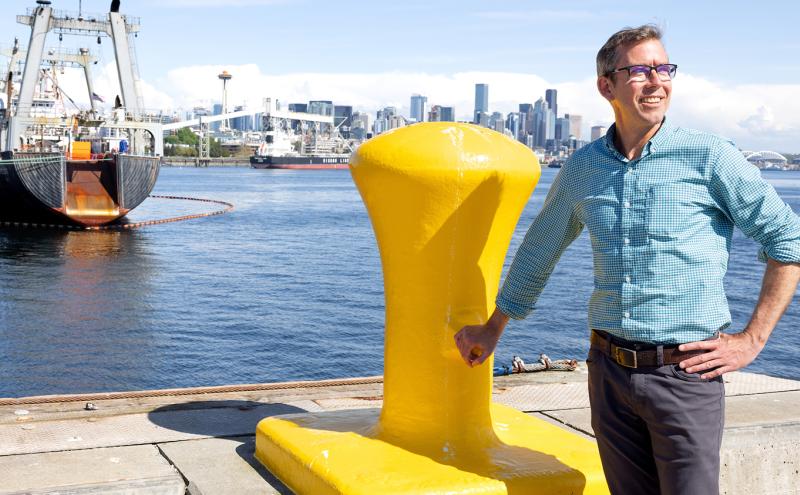
By Jessica Brown, Environmental Program Manager, and Cathy Swift
The Port of Seattle serves as an economic engine for our region, supporting 120,000 local jobs and $38 billion dollars in economic activity and spans a wide range of business functions including aviation, recreational marinas, commercial real estate, maritime, commercial fishing, and a globally-connected seaport. Our region has prioritized sustainability and equity and the Port has taken a leadership role. My role is to help improve transparency around how the Port incorporates sustainability and equity into our capital program and operational decisions.
One important factor is that the Port is a landlord port — that means that most operations are managed by tenants who are governed by berthing agreements, leases, and tariffs. Therefore, the Port does not have direct control over most of the maritime activity that occurs at Port facilities, and we must work with our tenants and partners to drive change.

Equity
Getting feedback from the community and hearing the lived experience of marginalized communities provides essential context in developing more equitable Port facilities. Elements of inclusion and equity include increasing access to: shorelines and the waterfront for the general public, restrooms for unhoused neighbors, drinking water and tree canopies during heat events, and bicycle and pedestrian right of way for all ages and abilities at public facilities. For example, the Sustainable Evaluation Framework process identified the need for more than 40 new trees at Terminal 91 to reduce the heat island effect and provide shade to warehouse workers.

Sustainability
Building sustainable facilities and programs focuses on: energy conservation, emissions reduction, potable water conservation, stormwater quality, waste management, sustainable transportation, equity, climate resilience, creating habitat and green space.
Sustainable Evaluation Framework
The Sustainable Evaluation Framework (SEF) is a Commission-driven policy designed to help the Port advance the Century Agenda goal to become the greenest and most energy-efficient port in North America and a model for equity, diversity, and inclusion. The SEF enables us to make more transparent and data-driven decisions to integrate sustainability and equity into building and operating Port facilities.
Capital projects go through the following SEF process:
- Assessment: Port environmental staff assess sustainability and equity opportunities early, typically during project inception.
- Collaboration: For projects with high substantial equity or environmental opportunity, the Port convenes internal subject matter experts at a Sustainable Project Assessment and Review Collaborative (SPARC) meeting to brainstorm opportunities. Stakeholders include sponsors, project managers, technical staff, and diversity, equity, and inclusion experts.
- Analysis: From here, a list of analyses is developed that will help the project team weigh tradeoffs between various sustainability and equity alternatives. These analyses may include carbon emissions, energy use, and other elements over the lifetime of the project.
- Briefing: Sustainability staff present the results and recommendations to the Commission’s Sustainability, Environment and Climate (SEAC) Committee. These briefings are typically when the project is around 30% design to allow project teams to incorporate Commissioner feedback into the project.
- Authorization: The final Sustainability Design Strategy is typically shared with the full Commission during construction authorization.
Keys to success
Transparency around how sustainability and equity decisions are made is key. And these tips can help.
1. Engage early
Establish a process to build in sustainability and equity as a foundational part of the process before 30% design, rather than tacking it on at later stages (which can increase cost and create schedule delays).
2. Get leadership support and document in policies
Port leaders are very committed to our environmental goals, so they improve our accountability by asking project teams “where are your sustainability and equity elements?”
3. Get the right people in the room
You can have a great idea, but many systems fail because stakeholders weren’t given a chance for buy-in or developing ideas up front. If someone who could identify a fatal flaw isn’t in the planning process, you could waste a lot of time and money.
Engage with community and external stakeholders. For example, the Port is currently meeting with the local maritime industry to discover where they are in fleet recapitalization (tugs, fishing boats) and low-carbon fuels. This feedback will inform infrastructure at the Port for the next 20 years.
4. Simplify the system
I assign a Tier level to indicate roughly how much sustainability and equity opportunity that project might have.
- Tier 1 projects are simple and can typically move forward with Port standards and code requirements and therefore don’t have to follow the full SEF process outlined above. Most projects are Tier 1, which enables Port staff to focus limited resources on projects with the most opportunity
- Tier 2 projects are more complex and may have a handful of sustainability or equity opportunities
- Tier 3 are the most complex projects with a lot of sustainability and equity opportunities
5. Understand the challenges
One of our biggest challenges is the perception that making projects sustainable and equitable will increase costs. Projects may have a higher cost up front due to sustainability and equity elements, but the lifecycle costs of sustainability measures can also be lower. One way we have addressed this challenge at the Port is by assigning a rough-order-magnitude cost for sustainability very early on. This helps project teams accommodate some of those up-front costs without time-consuming change orders.
6. Create accountability
Establish a process for accountability to achieve the objectives by building it into performance reviews and leadership checkpoints
Story of success
This case study shows how the process was successfully applied early in project inception.
The Port has a project renovating two berths at Terminal 91. I learned through the SEF brainstorming session that tenants were spending a lot of money each season on sewage management. They have to rent tanks, pump vessel sewage into the tanks, and coordinate an offsite trucking company to come pump the tanks out for disposal.
Through the SEF evaluation process, the environmental team assessed installing a direct-sewage discharge line. The results showed that we could save the tenant a lot of money, reduce logistical hassles of coordinating tank rentals and sewage disposal, clear up operational space on the pier, recoup installation costs within a reasonable timeframe, and reduce emissions and diesel pollution in the communities around the facility. Our early engagement and Sustainable Evaluation Framework resulting in a win-win scenario!








